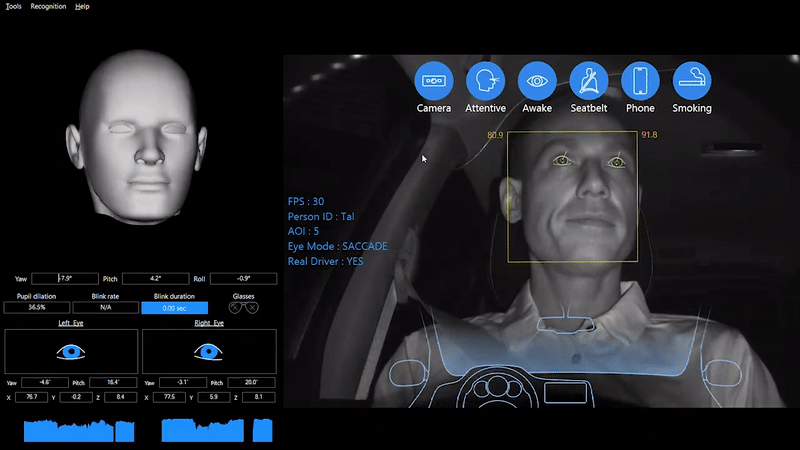Driver Monitoring Systems In Vehicles, Working, Driver Sleepy Alert
Hello Guys, welcome back to our blog. Here in this article, we will discuss driver monitoring systems in vehicles, it’s working like how the system will alter the driver if they feel sleepy, and the benefits of using it.
Ask questions if you have any electrical, electronics, or computer science doubts. You can also catch me on Instagram – CS Electrical & Electronics.
Also, read:
- Top 100 Automotive Interview Questions With Answers For Engineers
- Cybersecurity Trends And Challenges In The Digital Age
- Natural Language Processing (NLP) In Computer Science
Driver Monitoring Systems In Vehicles
The realm of vehicle safety has witnessed remarkable advancements in recent years, with technology playing a pivotal role in averting potential accidents and mitigating risks on the roads. Among these innovations stands the Driver Monitoring System (DMS), alternatively referred to as the Driver State Sensing (DSS) system, a cutting-edge safety feature designed to address one of the most pervasive dangers on the roads – drowsy driving. By leveraging sophisticated camera technology and intelligent algorithms, DMS serves as a vigilant guardian, constantly monitoring the driver’s state of alertness and intervening when signs of drowsiness are detected.
DMS operates on the principle of proactive accident prevention, recognizing that driver fatigue poses a significant threat to road safety. Through the strategic placement of two or more cameras, typically within the vehicle’s cabin, this system continuously tracks the driver’s eye movements and facial expressions. By analyzing these visual cues, DMS can assess the driver’s level of attention and promptly issue alerts if signs of drowsiness or distraction are detected. Moreover, with the integration of infrared LEDs, DMS ensures seamless operation day and night, overcoming challenges posed by low-light conditions and even detecting eyes obscured by sunglasses.
Beyond its primary function of monitoring the driver’s alertness, DMS encompasses a broader scope of surveillance, extending to the detection of multitasking behaviors such as eating, drinking, or engaging with electronic devices. This comprehensive approach underscores the system’s versatility and its ability to adapt to the complexities of modern driving environments. By scrutinizing various facets of driver behavior, DMS provides a holistic assessment of the driver’s cognitive engagement, thereby enhancing overall road safety.
The imperative for advanced safety features, including DMS, arises from the alarming surge in road accidents witnessed globally. As the number of vehicles on the roads continues to rise, so too does the incidence of traffic collisions, highlighting the urgent need for proactive measures to mitigate risks and safeguard lives. Vehicles equipped with DMS offer a tangible solution to this pressing issue, serving as a proactive deterrent against accidents caused by driver fatigue or inattention.
However, despite the undeniable benefits of DMS in enhancing road safety, its widespread adoption faces significant challenges, primarily stemming from cost considerations. The installation of sophisticated safety systems entails additional expenses, contributing to the overall cost of vehicles. As consumers weigh the benefits of advanced safety features against their financial implications, market dynamics come into play, influencing the trajectory of DMS adoption and its impact on the automotive industry.
Working of Driver Monitoring Systems
The Driver Monitoring System (DMS), also known as the Driver State Sensing (DSS) system, represents a paradigm shift in automotive safety technology, addressing the pervasive risk of drowsy driving. By leveraging cutting-edge camera technology and advanced algorithms, DMS functions as an ever-vigilant guardian, actively monitoring the driver’s state of alertness and intervening when signs of fatigue are detected. This system operates on the fundamental principle of preemptive accident prevention, recognizing that driver drowsiness poses a critical threat to road safety.
01. Detection Mechanisms:
At the heart of the DMS’s functionality lies its sophisticated detection mechanisms, which are meticulously engineered to discern subtle changes in the driver’s behavior indicative of drowsiness. Through the strategic placement of multiple cameras within the vehicle’s cabin, DMS continuously tracks the driver’s eye movements and facial expressions. By analyzing these visual cues in real time, the system can gauge the driver’s level of alertness and issue timely alerts if signs of fatigue or distraction are identified. Moreover, with the integration of infrared LEDs, DMS ensures seamless operation day and night, overcoming challenges posed by low-light conditions and even detecting eyes obscured by sunglasses.
02. Intervention Strategies:
Upon detecting indications of drowsiness or diminished alertness, DMS employs a range of intervention strategies to prompt the driver to regain focus and mitigate the risk of accidents. These interventions may take various forms, including auditory alerts, visual warnings displayed on the vehicle’s dashboard, or tactile feedback through the steering wheel or seat. Additionally, some advanced DMS implementations may incorporate adaptive cruise control or lane-keeping assist systems to provide supplementary assistance in maintaining vehicle control during moments of reduced alertness.
03. Customization and Adaptability:
Recognizing the diverse needs and preferences of drivers, modern DMS solutions offer a high degree of customization and adaptability. Users can often tailor the system’s sensitivity levels, alert thresholds, and intervention preferences to align with their individual driving habits and preferences. Furthermore, DMS can adapt its monitoring parameters based on factors such as driving conditions, time of day, and the duration of the journey, ensuring optimal performance across a range of scenarios.
04. Integration with Vehicle Systems:
In addition to its primary function of alerting drivers to signs of drowsiness, DMS is increasingly integrated with other vehicle systems to enhance overall safety and convenience. For example, some DMS implementations may communicate with adaptive lighting systems to adjust headlight brightness based on the driver’s level of alertness. Similarly, DMS may collaborate with adaptive cruise control and lane-keeping assist systems to provide seamless integration and a holistic approach to driver assistance.
Benefits of Driver Monitoring Systems
Driver Monitoring Systems (DMS) offers a multitude of benefits aimed at enhancing road safety and driver well-being:
01. Accident Prevention: DMS serves as a proactive safeguard against accidents caused by drowsy driving, alerting drivers when signs of fatigue or distraction are detected. By intervening before a critical event occurs, DMS helps prevent potentially catastrophic accidents, saving lives and reducing injury rates on the roads.
02. Increased Awareness: By continuously monitoring the driver’s level of alertness and engagement, DMS promotes greater awareness and attentiveness behind the wheel. Real-time feedback alerts drivers to moments of diminished focus, encouraging them to reassert their attention and maintain safe driving practices.
03. Personalized Safety: Modern DMS solutions offer customization options that allow drivers to tailor the system’s sensitivity levels and intervention preferences to suit their individual needs and driving habits. This personalized approach ensures that the system adapts to the unique characteristics of each driver, optimizing its effectiveness in promoting safety.
04. Adaptive Intervention: DMS systems employ a variety of intervention strategies, including auditory alerts, visual warnings, and tactile feedback, to prompt drivers to regain focus and mitigate the risk of accidents. Some advanced implementations may even integrate with other vehicle systems, such as adaptive cruise control or lane-keeping assist, to provide supplementary assistance during moments of reduced alertness.
05. Enhanced Comfort: Beyond safety benefits, DMS can also contribute to driver comfort by minimizing unnecessary alerts and interventions during periods of normal driving behavior. By striking a balance between safety and convenience, DMS ensures a smoother and more enjoyable driving experience for motorists.
06. Regulatory Compliance: With the increasing emphasis on road safety regulations worldwide, DMS systems help ensure compliance with legal requirements related to driver monitoring and fatigue management. By implementing robust safety measures, vehicle manufacturers and fleet operators can demonstrate their commitment to prioritizing safety and minimizing risks on the roads.
07. Data Insights: DMS systems generate valuable data insights regarding driver behavior and performance, which can be leveraged for various purposes, including driver training, risk assessment, and fleet management. By analyzing trends and patterns in driver attentiveness, organizations can identify areas for improvement and implement targeted interventions to enhance safety outcomes.
Overall, Driver Monitoring Systems offer a comprehensive suite of benefits that not only enhance road safety but also contribute to driver comfort, regulatory compliance, and data-driven decision-making in the automotive industry. As technology continues to evolve, DMS systems will play an increasingly vital role in promoting safer and more responsible driving practices for all road users.
This was about “Driver Monitoring Systems In Vehicles“. I hope this article may help you all a lot. Thank you for reading.
- Roadmap To Become A Successful Hardware-in-the-Loop (HiL) Engineer
- 1000+ Automotive Interview Questions With Answers
- RTOS In The Automotive Industry: The Brains Behind Real-Time Vehicle Control
- High Performance Computers in Software-Defined Vehicles (SDVs): Architecture, Challenges, and Future Trends
- Automotive HPC Wars: The Race To Power Software-Defined Vehicles
- Why The Automotive Industry Is Down: No Automotive Jobs and When Will It Become Normal Again?
- Lane Departure Warning Systems: Your Guardian on the Road
- In-Depth Guide To UDS Service 0x19 – ReadDTCInformation


